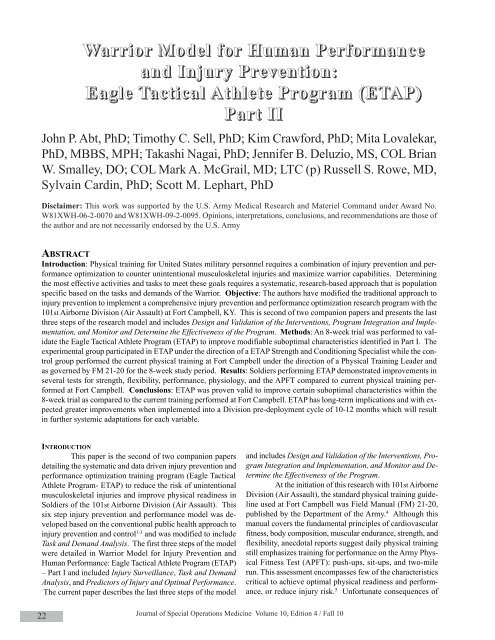Fall - United States Special Operations Command
Fall - United States Special Operations Command
Fall - United States Special Operations Command
You also want an ePaper? Increase the reach of your titles
YUMPU automatically turns print PDFs into web optimized ePapers that Google loves.
22<br />
Warrior Model for Human Performance<br />
and Injury Prevention:<br />
Eagle Tactical Athlete Program (ETAP)<br />
Part II<br />
John P. Abt, PhD; Timothy C. Sell, PhD; Kim Crawford, PhD; Mita Lovalekar,<br />
PhD, MBBS, MPH; Takashi Nagai, PhD; Jennifer B. Deluzio, MS, COL Brian<br />
W. Smalley, DO; COL Mark A. McGrail, MD; LTC (p) Russell S. Rowe, MD,<br />
Sylvain Cardin, PhD; Scott M. Lephart, PhD<br />
Disclaimer: This work was supported by the U.S. Army Medical Research and Materiel <strong>Command</strong> under Award No.<br />
W81XWH-06-2-0070 and W81XWH-09-2-0095. Opinions, interpretations, conclusions, and recommendations are those of<br />
the author and are not necessarily endorsed by the U.S. Army<br />
ABSTRACT<br />
Introduction: Physical training for <strong>United</strong> <strong>States</strong> military personnel requires a combination of injury prevention and performance<br />
optimization to counter unintentional musculoskeletal injuries and maximize warrior capabilities. Determining<br />
the most effective activities and tasks to meet these goals requires a systematic, research-based approach that is population<br />
specific based on the tasks and demands of the Warrior. Objective: The authors have modified the traditional approach to<br />
injury prevention to implement a comprehensive injury prevention and performance optimization research program with the<br />
101st Airborne Division (Air Assault) at Fort Campbell, KY. This is second of two companion papers and presents the last<br />
three steps of the research model and includes Design and Validation of the Interventions, Program Integration and Implementation,<br />
and Monitor and Determine the Effectiveness of the Program. Methods: An 8-week trial was performed to validate<br />
the Eagle Tactical Athlete Program (ETAP) to improve modifiable suboptimal characteristics identified in Part I. The<br />
experimental group participated in ETAP under the direction of a ETAP Strength and Conditioning <strong>Special</strong>ist while the control<br />
group performed the current physical training at Fort Campbell under the direction of a Physical Training Leader and<br />
as governed by FM 21-20 for the 8-week study period. Results: Soldiers performing ETAP demonstrated improvements in<br />
several tests for strength, flexibility, performance, physiology, and the APFT compared to current physical training performed<br />
at Fort Campbell. Conclusions: ETAP was proven valid to improve certain suboptimal characteristics within the<br />
8-week trial as compared to the current training performed at Fort Campbell. ETAP has long-term implications and with expected<br />
greater improvements when implemented into a Division pre-deployment cycle of 10-12 months which will result<br />
in further systemic adaptations for each variable.<br />
INTRODUCTION<br />
This paper is the second of two companion papers<br />
detailing the systematic and data driven injury prevention and<br />
performance optimization training program (Eagle Tactical<br />
Athlete Program- ETAP) to reduce the risk of unintentional<br />
musculoskeletal injuries and improve physical readiness in<br />
Soldiers of the 101st Airborne Division (Air Assault). This<br />
six step injury prevention and performance model was developed<br />
based on the conventional public health approach to<br />
injury prevention and control 1-3 and was modified to include<br />
Task and Demand Analysis. The first three steps of the model<br />
were detailed in Warrior Model for Injury Prevention and<br />
Human Performance: Eagle Tactical Athlete Program (ETAP)<br />
– Part I and included Injury Surveillance, Task and Demand<br />
Analysis, and Predictors of Injury and Optimal Performance.<br />
The current paper describes the last three steps of the model<br />
and includes Design and Validation of the Interventions, Program<br />
Integration and Implementation, and Monitor and Determine<br />
the Effectiveness of the Program.<br />
At the initiation of this research with 101st Airborne<br />
Division (Air Assault), the standard physical training guideline<br />
used at Fort Campbell was Field Manual (FM) 21-20,<br />
published by the Department of the Army. 4 Although this<br />
manual covers the fundamental principles of cardiovascular<br />
fitness, body composition, muscular endurance, strength, and<br />
flexibility, anecdotal reports suggest daily physical training<br />
still emphasizes training for performance on the Army Physical<br />
Fitness Test (APFT): push-ups, sit-ups, and two-mile<br />
run. This assessment encompasses few of the characteristics<br />
critical to achieve optimal physical readiness and performance,<br />
or reduce injury risk. 5 Unfortunate consequences of<br />
Journal of <strong>Special</strong> <strong>Operations</strong> Medicine Volume 10, Edition 4 / <strong>Fall</strong> 10

















